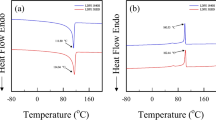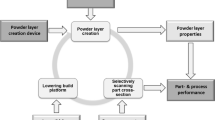Abstract
Theoretical and experimental relationships are considered for the strength of green compacts in relation to various properties of the powder (particle material strength, particle size and shape, and apparent powder density), together with the formation conditions (pressure) and test conditions. The effects of the powder properties, in particular the apparent density, may be examined from simple relationships of the form “strength - pressing density” with the use of a correction coefficient. One needs to use ideas from the mechanics of compressible media in considering the state of strain in the pressing and the test conditions.
Similar content being viewed by others
REFERENCES
M. Yu. Bal’shin, Powder Metallography [in Russian], Metallurgizdat, Moscow (1948).
R. L. Sands and J. F. Watkinson, “Sintered stainless steel powders. Part 1,” Precis. Metal. Mold., 18, No. 12, 41–42 (1960).
I. Nikolakakis and N. Pilpel, “Effect of particle shape on the tensile strengths of powders,” Powder Technol., 42, No. 3, 279–283 (1985).
M. Yu. Bal’shin, Powder Metallurgy [in Russian], Mashgiz, Moscow (1948).
R. P. Seelig, “Fundamentals of pressing of metal powder,” The Physics of Powder Metallurgy, W. E. Kingston (ed.), McGraw-Hill: Book Comp. Inc. (1951), pp. 344–371.
R. Farley and F. H. H. Valentin, “Effect of particle size upon strength of powder,” Powder Technol., 1, No. 6, 344–354 (1968).
E. Klar and W. M. Shafer, “On the nature of green strength. II. Correlations between pore structure of powder particles and their electrical conductivity and strength in the compacted state,” Int. J. Powder Met., 5, No. 4, 5–16 (1969).
A. K. Radchenko, “Effects of hardness and plasticity in powder particle material on the shaping and strength of green pressings,” Current Topics in Physical Metallography [in Russian], Institute for Problems of Materials Science, Academy of Sciences of USSR, Kiev (1990), pp. 32–36.
R. Angers and A. Couture, “A new approach to increasing the compressibility of iron powder,” Int. J. Powder Met., 22, No. 2, 81–89 (1986).
A. F. Zhornyak and V. E. Oliker, “Trends in the pressing of sprayed iron powders. I. Effects of porous particle structure on compaction and mutual adhesion,” Poroshk. Metall., No. 2, 23–29 (1981).
A. F. Zhornyak and V. E. Oliker, “Effects of grain-size composition of sprayed iron powder on the technological properties of that powder and mixtures of it with zinc stearate,” Poroshk. Metall., No. 4, 1–5 (1978).
N. Claussen and J. Jahn, “Green strength of metal and ceramic compacts as determined by the indirect tensile test,” Powder Met. Int., 2, No. 3, 87–90 (1970).
A. K. Radchenko, “Strips of composite solders based on the copper-phosphorus system,” Advances in Making and Using Phosphides and Phosphorus-Containing Alloys, in 2 Volumes, Vol. 1 [in Russian], Nauka, Alma-Ata (1988), pp. 59–63.
A. F. Zhornyak and V. E. Oliker, “Effects of grain-size composition in sprayed iron powder and its mixtures with reduced powder on the properties of pressed and sintered materials,” Poroshk. Metall., No. 7, 86–90 (1978).
J. P. Jernot and J. L. Chermant, “Compression isostatique de poudre de cobalt,” Memoire Scientifique de la Revue Metallurgie, No. 10, 581–588 (1979).
I. H. Moon and K. H. Kim, “Relationship between compacting pressure, green density, and green strength of copper powder compacts,” Powder Met., 27, No. 2, 80–84 (1984).
D. Bortzmeyer, “Tensile strength of ceramic powders,” J. Mat. Sci., 27, No. 12, 3305–3308 (1992).
G. V. Samsonov and M. S. Koval’chenko, Hot Pressing [in Russian], Gostekhizdat, Kiev (1962).
G. A. Baglyuk, G. E. Mazharova, S. N. Kaplya, et al., “Pressing blanks made of gas-sprayed high-speed steel powders,” Poroshk. Metall., No. 7, 9–12 (1990).
S. Baklouti, T. Chartier, and F. Baumard, “Mechanical properties of dry-pressed ceramic green products: The effect of their binder,” J. Amer. Ceram. Soc., 80, No. 8, 1992–1996 (1997).
L. N. Satapathy, “Effect of water soluble binders on the green properties of alumina ceramics,” Interceram., 49, No. 6, 448–453 (2000).
E. Klar and W. M. Shafer, “On the nature of green strength,” Int. J. Powder Met., 5, No. 2, 5–10 (1969).
E. B. Lozhechnikov, L. A. Rapoport, V. P. Chulkov, and V. I. Vasyukin, “Structure of the links between powder particles and their effects on the material working,” Proceedings of the All-Union Conference on Research and Development in Theoretical Aspects of Powder Metallurgy and Protective Coatings, 24–26 May 1983, Minsk [in Russian], Minsk (1984), pp. 116–118.
A. P. Bogdanov and O. V. Roman, “Structure and properties of pressings made of iron powder obtained by dynamic pressing,” Powder Metallurgy: Proceedings of the 8th All-Union Conference on Progressive Methods of Making Components From Powders [in Russian], Vyssh. Shk., Minsk (1966), pp. 228–231.
A. H. Gerritsen, “The influence of the degree of stress anisotropy during consolidation on the strength of cohesive powdered materials,” Powder Technol., 43, No. 1, 61–70 (1985).
A. F. Zhornyak and V. E. Oliker, “Trends in the pressing of sprayed iron powders. III. Effects of zinc stearate on the compaction and particle adhesion,” Poroshk. Metall., No. 5, 16–22 (1981).
M. Yu. Bal’shin, “Dependence of the mechanical properties of powder metals on the porosity and the ultimate properties of powder cermet materials,” Dokl. AN SSSR, 67, No. 5, 831–834 (1949).
Yu. N. Semenov, “Determining the strength of metal powder pressings,” Zavod. Lab., No. 10, 1240–1247 (1958).
I. M. Fedorchenko, G. A. Vinogradov, and O. A. Katrus, “A study of the properties of strips made from iron powder,” Poroshk. Metall., No. 4, 70–79 (1961).
M. Yu. Bal’shin, Scientific Principles of Powder and Fiber Metallurgy [in Russian], Metallurgiya, Moscow (1972).
Yu. E. Vya’ and A. M. Laptev, “A study of the strength of green powder pressings in axial and radial loading,” Poroshk. Metall., Nos. 5–6, 38–42 (2002).
M. Strömgren, H. Aström, and K. Easterling, “The effect of interparticle contacts area on the strength of cold-pressed aluminium powder compacts,” Powder Metal., 16, No. 32, 155–165 (1973).
A. K. Radchenko and V. Yu. Starchenko, “A study of the strength in shear for green strips of composite solders,” Current Topics in Physical Metallography [in Russian], Institute for Problems of Materials Science, National Academy of Sciences of Ukraine, Kiev (1997), pp. 94–102.
G. I. Aksenov, The Principles of Powder Metallurgy [in Russian], Kuibyshev Kn. Izd., Kuibyshev (1962).
N. V. Shepel’skii and V. N. Kornilov, “Effects of strain degree on the renewal of granule surfaces during pressing,” Tekhnologiya Legkikh Splavov, No. 6, 29–34 (1981).
V. N. Kornilov and N. V. Shepel’skii, “Effects of renewal of granule contact surfaces on the seizure strength,” Tekhnologiya Legkikh Splavov, No. 2, 22–25 (1985).
B. A. Aref’ev, V. V. Kuleshov, and V. M. Panovko, “Regularities in joins between powder particles in plastic deformation,” Poroshk. Metall., No. 8, 15–20 (1991).
E. I. Gutmanas and A. Lawley, “Cold sintered — a new powder consolidation process,” Annu. Powder Met. Conf. Proc. (May 1–4, 1983, New Orleans, La), Princeton, New York (1984), pp. 653–667.
E. I. Gutmanas, Y. Schefer, and D. Zak, “Mechanical properties and microstructure of cold sintered ferrous alloys and composites,” Int. Conf. on Powder Metallurgy (P/m-82 in Europe, June 20–25, 1982, Milan and Florence, Italy), Milan and Florence (1982), pp. 643–650.
E. I. Gutmanas, “High pressure compaction and cold sintered of stainless steels powders,” Powder Met. Int., 12, No. 4, 378–382 (1980).
Yu. G. Dorofeev and V. A. Skorikov, “Intergrowth at contact surfaces for metal particles in hot dynamic pressing,” Poroshk. Metall., No. 6, 43–47 (1975).
P. Kasiraj, T. Vreeland, R. B. Schwarz Jr., and T. J. Ahrens, “Shock consolidation of rapidly solidified steel powder,” Acta Metal., 32, No. 8, 1235–1241 (1984).
P. Doremus, F. Toussaint, and O. Alvain, “Simple tests standard procedure for the characterization of green compacted powder,” Recent Developments in Computer Modeling of Powder Metallurgy Processes, A. Zavaliangos and A. Laptev (eds.), IOS Press, Amsterdam, Berlin, Oxford, Tokyo, and Washington (2001), pp. 282–293.
B. W. Darvell, “Uniaxial compression tests and the validity of indirect tensile strength,” J. Mat. Sci., 25, No. 2A, 757–780 (1990).
T. Sheppard and H. B. Meshane, “Strength of cold-pressed compacts,” Powder Metal., No. 3, 120–125 (1980).
D. M. Ashton, R. Farley, and F. H. H. Valentin, “An improved apparatus for measuring the tensile strength of powders,” J. Sci. Instrum., 41, No. 12, 763–765 (1964).
D. K. Worn and R. P. Penks, “Fabrication of strips to poor nickel by powder rolling,” Powder Metal., No. 3, 45–49 (1959).
K. Easterling and A. R. Thölen, “The role of surface energy and powder geometry in powder compaction,” Powder Metal., 16, No. 31, 112–118 (1973).
A. K. Radchenko and O. A. Katrus, “Shapability and strength in powder rollings,” Poroshk. Metall., No. 7, 11–18 (1987).
V. K. Golubev and K. G. Rabinovich, “Effects of the initial state on the strength of pressed lithium hydride,” Probl. Prochnosti, No. 6, 134–150 (1999).
I. M. Fedorchenko, “A study on the specific surface of metal powders,” Izv. AN SSSR, Tekhn. Nauki, No. 3, 411–418 (1951).
L. Parilak, E. Dudrova, and E. Rudnayova, “Aproximativne vyjadrenie lisovacej krivky technickich pra kovych kovov,” Pokzoky Pra kove Metalurgie, No. 3, 19–30 (1983).
S. V. Muchnik, A. K. Radchenko, O. A. Katrus, et al., “Production and shaping of copper phosphide Cu3P powders,” Poroshk. Metall., No. 11, 24–27 (1992).
N. I. Shcherban’, “Effects of porosity on the mechanical properties of materials made by powder metallurgy,” Poroshk. Metall., No. 9, 57–73 (1973).
E. Ryshkewitsh, “Compression strength of porous sintered alumina and zirconia,” J. Amer. Ceram. Soc., 36, No. 2, 65–68 (1953).
B. Ya. Pines, A. F. Sirenko, and N. I. Sukhinin, “Trends in the mechanical strength in bodies made by sintering metal powders,” Researches on Heat-Resisting Alloys, Vol. 3 [in Russian], Izd. AN SSSR, Moscow (1958), pp. 326–339.
V. T. Troshchenko and V. N. Rudenko, Strength in Cermet Materials and Methods of Determining It [in Russian], Tekhnika, Kiev (1965).
G. F. Tikhonov and V. A. Vasil’ev, “Effects of the temperature-time factor on sintering and the properties of cermet specimens,” Tr. Gor’k. Politekhn. Inst.,. 28, Issue 8, 21–24 (1972).
V. V. Skorokhod, “Physicomechanical properties of porous materials,” Powder Metallurgy’77 [in Russian], Nauk. Dumka, Kiev (1977), pp. 120–129.
M. Shtern and O. Mikhailov, “Defects formation in die compaction: Prediction and numerical analysis,” Proc. of Powder Metallurgy European Congress (22–24 October 2001, Nice, France), Vol. 3, Nice (2001), pp. 50–57.
I. Sandler, F. L. DiMaggio, and Y. Baladi, “Generalized cap model for geological materials,” J. Geotechn. Engineer. Division ASCE, 102, No. GT7, 683–699 (1976).
O. Coube and H. Riedel, “Numerical simulation of metal powder die compaction with special consideration of cracking,” Powder Metal., 43, No. 2, 123–131 (2000).
Hibbitt, Karlsson, and Sorensen, Inc. ABAQUS Explisit: Users, Example Problems, and Theory Manuals, Version 5.8 (1998).
A. K. Radchenko, “Choosing a particle shape criterion in application to forming,” Current Topics in Physical Metallography [in Russian], Institute for Problems of Materials Science, National Academy of Sciences of Ukraine, Kiev (2002), pp. 42–50.
M. B. Shtern and A. C. F. Cocks, “The structure of constitutive laws for compaction of metal powders,” Recent Development in Computer Modelling of Powder Metallurgy Processes, IOS Press, Amsterdam, Berlin, Oxford, Tokyo, and Washington (2001), pp. 71–81.
M. Shtern, “On the constitutive potentials for powders and porous bodies,” Mechanics of Granular and Porous Materials, N. A. Fleck and A. C. F. Cocks (eds.), Kluwer Academic Publishers, Dordrecht (1997), pp. 1–10.
V. S. Zolotarevskii, Mechanical Properties of Metals [in Russian], Metallurgiya, Moscow (1983).
E. M. Mikhailovskii, “Determining the ultimate strength of a brittle material in tension,” Probl. Prochnosti, No. 11, 53–56 (1976).
V. M. Kornev, A. G. Demeshkin, and T. A. Korneva, “Theoretical and experimental estimates of the brittle strength of bodies made by compacting powders,” Prikl. Mekhanika i Teoret. Fizika, 40, No. 5, 208–215 (1999).
Author information
Authors and Affiliations
Additional information
Translated from Poroshkovaya Metallurgiya, Nos. 9–10(439), pp. 12–27, September–October, 2004.
Rights and permissions
About this article
Cite this article
Radchenko, A.K. Mechanical properties of unsintered pressing. I. Phenomenological relations for unsintered pressing strength. Powder Metall Met Ceram 43, 447–460 (2004). https://doi.org/10.1007/s11106-005-0004-7
Received:
Issue Date:
DOI: https://doi.org/10.1007/s11106-005-0004-7




